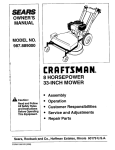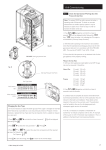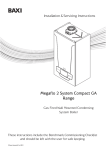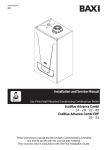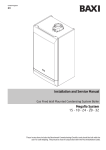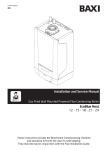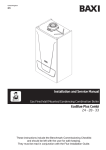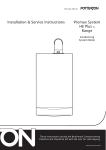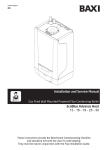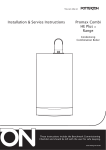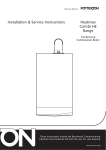Download Megaflo Compact GA installations instructions part 2
Transcript
10.0 Commissioning 10.2 Flue Sampling Point Checking the Combustion - ‘Chimney Sweep’ Function 1. To set the boiler to operate at MAXIMUM and MINIMUM, press & together and hold for at least 6 seconds. ‘On’ will be displayed briefly, followed by ‘304’ then the boiler output expressed as percentage i.e. ‘100’. Plug Analyser Probe Fig. 36a 2. Press input. until ‘00’ is displayed, indicating minimum 3. To exit the function press seconds. & together for 6 4. The combustion (CO level and CO/CO2 ration) must be measured and recorded at MAXIMUM DHW input and MINIMUM input. 5. Follow the flow chart on the next page to comply with the requirement to check combustion on commissioning. 6. The system MUST be cold to ensure the boiler is operating under full demand © Baxi Heating UK Ltd 2014 27 Set Boiler to Maximum Rate (see 10.2.1) Allow the combustion to stabilise. Do not insert probe to avoid ‘flooding’ the analyser. Verify Flue Integrity Indication that products of combustion & inlet air are mixing - further investigation is required. Check all flue components are correctly assembled, fixed & supported. Check the flue & terminal are unobstructed. Is O2 ≥ 20.6% and CO2 < 0.2% ? No TURN APPLIANCE OFF ! Call 0844 871 1555 for advice. The appliance MUST NOT be commissioned until all problems are identified and resolved. 10.0 Commissioning 10.2 1. This procedure is mandatory in GB from April 2014. It is strongly recommended to perform the procedure before that date. Perform Flue Integrity Combustion Check Insert the analyser probe into the air inlet test point, allowing the reading to stabilise. No Is O2 ≥ 20.6% and CO2 < 0.2% ? Check CO & Combustion Ratio at Maximum Rate Whilst the boiler is still operating at maximum insert the analyser probe into the flue gas test point, allowing the reading to stabilise. Yes Yes Checking the Combustion - ‘Chimney Sweep’ Function (cont) No Is CO < 350ppm and CO/CO2 ratio < 0.004 ? Verify Integrity of Seals Check all burner seals, internal flue seals, door & case seals. Replace any seals that appear unsound. Is CO < 350ppm and CO/CO2 ratio < 0.004 ? Yes Set Boiler to Minimum Rate (see 10.2.2) Allow the combustion to stabilise. Do not insert probe to avoid ‘flooding’ the analyser. Check CO & Combustion Ratio at Minimum Rate Whilst the boiler is operating at minimum insert the analyser probe into the flue gas test point, allowing the reading to stabilise. Yes No TURN APPLIANCE OFF ! Call 0844 871 1555 for advice. The appliance MUST NOT be commissioned until all problems are identified and resolved. If commissioning cannot be fully completed the appliance must be disconnected from the gas supply in accordance with the GSIUR. Note: Check & record the CO & combustion ratio at both maximum & minimum rates before calling 0844 871 1555. 28 © Baxi Heating UK Ltd 2014 No Is CO < 350ppm and CO/CO2 ratio < 0.004 ? Yes BOILER OPERATING SATISFACTORILY. NO FURTHER ACTION REQUIRED Ensure test points are capped, the boiler case front panel is correctly fitted & secured and all other commissioning procedures completed. Complete the ‘Benchmark’ Checklist, recording the CO & combustion ratio readings as required. 10.0 Commissioning 10.3 Check the Operational (Working) Gas Inlet Pressure & Gas Rate Note: The system MUST be cold to ensure the boiler is operating under full demand. 1. Press & together and hold for at least 6 seconds. ‘On’ will be displayed briefly, followed by ‘304’ then ‘100’ when the boiler is lit, indicating the output is at MAXIMUM (‘Chimney Sweep Function’). 2. With the boiler operating in the maximum rate condition check that the operational (working) gas pressure at the inlet gas pressure test point on the gas cock or valve is in accordance with B.S. 6798 & B.S. 6891. This must be AT LEAST 17mb ! (LPG - 37mb) Measure the Gas Rate 4. With any other appliances & pilot lights turned OFF the gas rate can be measured. It should be:- DO NOT check gas pressure here Fig. 37 Inlet Gas Pressure Test Point Fig. 38 Gas Type Label Natural Gas 12 model 15 model 18 model 24 model 28 model 32 model 1.27 m3/h 1.59 m3/h 1.90 m3/h 2.54 m3/h 2.96 m3/h 3.40 m3/h Propane 12 model 15 model 18 model 24 model 28 model 32 model 0.93 kg/h 1.17 kg/h 1.4 kg/h 1.86 kg/h 2.18 kg/h 2.49 kg/h 5. Press & together and hold for at least 6 seconds to exit the function. N.G. Factory Set 6. Carefully read and complete all sections of the Benchmark Commissioning Checklist at the rear of this publication that are relevant to the boiler and installation. These details will be required in the event of any warranty work. The publication must be handed to the user for safe keeping and each subsequent regular service visit recorded. When reset for L.P.G. Changing the Gas Type 1. It may be necessary to adjust the boiler gas type if the supply is changed, for example when Natural Gas is provided to a rural area previously reliant on Propane. In these instances a replacement Gas Type Label may be required, which is available on request as a spare part.. 2. Press & alternating with . 3. Press to select the next parameter 4. Press or gas type. For Natural Gas:For Propane:5. Press and hold for at least 6 seconds. will be displayed, . to select the value that corresponds with the required to save the change, then © Baxi Heating UK Ltd 2014 . Press 7. For IE, it is necessary to complete a “Declaration of Conformity” to indicate compliance with I.S. 813. An example of this is given in I.S. 813 “Domestic Gas Installations”. This is in addition to the Benchmark Commissioning Checklist. R to return to the normal display. 29 11.0 Completion & System Draining 11.1 Completion 1. Replace the case front panel, and secure with the screws previously removed. 2. This publication must be handed to the user for safe keeping and each subsequent regular service visit recorded. Case Front Panel 3. Set the central heating and hot water temperatures to the requirements of the user. Instruct the user in the operation of the boiler and system. 4. Instruct the user in the operation of the boiler controls. Hand over the User’s Operating, Installation and Servicing Instructions, giving advice on the necessity of regular servicing. 5. Demonstrate to the user the action required if a gas leak occurs or is suspected. Show them how to turn off the gas supply at the meter control, and advise them not to operate electric light or power switches, and to ventilate the property. Facia Panel Fig. 39 To change the information displayed see the table below:The button can be pressed so that the display shows the following information:1 press - ‘00’ alternates with Sub-Code (only when fault on boiler) or ‘000’ 2 presses - ‘01’ alternates with CH Flow Temperature 3 presses - ‘02’ alternates with Outside Temperature (where Sensor fitted) 4 presses - ‘03’ alternates with DHW Temperature 5 presses - ‘04’ alternates with DHW Temperature 6 presses - ‘05’ alternates with System Water Pressure 7 presses - ‘06’ alternates with CH Return Temperature 8 presses - ‘07’ alternates with Flue Temperature 9 presses - ‘08’ alternates with Heat Exchanger Temperature 6. Show the user the location of the system control isolation switch, and demonstrate its operation. 7. Advise the user that they may observe a plume of vapour from the flue terminal, and that it is part of the normal operation of the boiler. 11.2 System Draining 1. If at any time after installation it is necessary to drain the central heating system (e.g. after replacing a radiator) the De-Aeration Function should be activated. 2. On refilling the system ensure that there is no heating or hot water demand, but that there is power to the boiler. 3. Press & together and hold for at least 6 seconds. The ‘De-Aeration’ Function will be activated. 4. The boiler pump will run for up to 10 minutes. This will purge air from the system. The display will show . 5. Once De-Aeration is complete set the external controls as required by the user. 30 © Baxi Heating UK Ltd 2014 12.0 Servicing Flue Sampling Point 12.1 Annual Servicing 1. For reasons of safety and economy, it is recommended that the boiler is serviced annually. Servicing must be performed by a competent person in accordance with B.S. 7967-4. Air Sampling Point 2. After servicing, complete the relevant Service Interval Record section of the Benchmark Commissioning Checklist at the rear of this publication. IMPORTANT: During routine servicing, and after any maintenance or change of part of the combustion circuit, the following must be checked:• The integrity of the complete flue system and the flue seals (check air inlet sample). • The integrity of the boiler combustion circuit and relevant seals as described in Section 12.2. • The operational gas inlet pressure as described in Section 10.2.1 to 10.2.7 and the gas rate as described in 10.2.8. • The combustion performance as described in ‘Check the Combustion Performance’ (12.1.4 to 12.1.6 below). 3. Competence to carry out Checking Combustion Performance B.S. 6798 ‘Specification for Installation & Maintenance of Gas Fired Boilers not exceeding 70kW’ advises that:- Case Front Panel Fig. 40 • The person carrying out a combustion measurement should have been assessed as competent in the use of a flue gas analyser and the interpretation of the results. Case Front Panel Securing Screws • The flue gas analyser used should be one meeting the requirements of BS7927 or BS-EN50379-3 and be calibrated in accordance with the analyser manufacturers’ requirements. • Competence can be demonstrated by satisfactory completion of the CPA1 ACS assessment, which covers the use of electronic portable combustion gas analysers in accordance with BS 7967, Parts 1 to 4. Check the Combustion Performance (CO/CO2 ratio) 4. Set the boiler to operate at maximum rate as described in Section 14.1.1 to 14.1.6. 5. Remove the plug from the flue sampling point, insert the analyser probe and obtain the CO/CO2 ratio. This must be less than 0.004. 6. If the combustion reading (CO/CO2 ratio) is greater than this, and the integrity of the complete flue system and combustion circuit seals has been verified, and the inlet gas pressure and gas rate are satisfactory either: • Perform the ‘Annual Servicing - Inspection’ (Section 12.2) & re-check • Adjust the gas valve (Section 14.0) & re-check • Replace the gas valve (Section 13.23) & re-check Control Box removed for clarity Condensate Trap 12.2 Gasket Annual Servicing - Inspection 1. Ensure that the boiler is cool. Sump 2. Ensure that both the gas and electrical supplies to the boiler are isolated. 3. Remove the screws securing the case front panel. Lift the panel slightly to disengage it from the studs on top of the case (Fig. 40) and hinge down the Control Box. Fig. 41 © Baxi Heating UK Ltd 2014 4. Disconnect the condensate drain pipe and unscrew the sump from the bottom of the condensate trap assembly (Fig. 41). Remove any deposits from the sump and trap. Clean as necessary and replace the sump. 31 4 ±0.5 12.0 Servicing 12.2 Annual Servicing Inspection (Cont) 5. Remove the clip securing the gas feed pipe to the air/gas venturi. Disconnect the pipe. Do not break the joint between the pipe and gas valve unless necessary. 6. Disconnect the electrode leads, noting their position, and the fan electrical plugs (Fig. 43). Flame Sensing Electrode 5± 1 Spark Ignition Electrode 10 ±1 Fig. 42 Electrode Position Fan, Collector and Cover Assembly Fig. 43 Electrode Leads Securing Clip 7. Undo the four nuts retaining the combustion box cover to the heat exchanger. 8. Carefully draw the fan, collector and cover assembly forward (Figs. 43). 9. Clean any debris from the heat exchanger and check that the gaps between the tubes are clear. 10. Inspect the burner, electrodes position and insulation, cleaning or replacing if necessary. Clean any dirt or dust from the air box. 11. Carefully examine all seals, insulation & gaskets, replacing as necessary. Look for any evidence of leaks or corrosion, and if found determine & rectify the cause. 12. Reassemble in reverse order, ensuring the front case panel is securely fitted. 13. Complete the relevant Service Interval Record section of the Benchmark Commissioning Checklist at the rear of this publication and then hand it back to the user. Gas Feed Pipe Control Box removed for clarity 32 © Baxi Heating UK Ltd 2014 13.0 Changing Components IMPORTANT: When changing components ensure that both the gas and electrical supplies to the boiler are isolated before any work is started. When the component has been changed recommission the boiler as described in Section 10.0. Always examine any seals or gaskets, replacing where necessary. The Case Front Panel MUST seal effectively against the air box side panels. Spark Ignition Electrode See Section 12.1 “Annual Servicing” for removal of case panel, door etc. Electrode Leads 13.1 Flame Sensing Electrode Spark Ignition and Flame Sensing Electrodes (Fig. 44) 1. Disconnect the electrode leads, noting their positions. 2. Remove the retaining screws securing each of the electrodes to the combustion box cover and remove the electrodes. Fig. 44 3. Check the condition of the sealing gaskets and replace if necessary. Reassemble in reverse order. 4. After changing the Flame Sensing Electrode check the combustion - see Section 14.1. 5. When satisfactory combustion readings are not obtained ensure the electrode position is correct and perform the combustion check again. Control Box removed for clarity 13.2 Fan (Fig. 45) 1. Remove the clip securing the gas feed pipe to the air/gas venturi. Disconnect the pipe. Cover 2. Undo the screws securing the air/gas collector to the cover (32) or extension piece (12 - 28) and disconnect the fan electrical plugs. Gasket 3. Remove the collector and fan assembly, being careful to retain the gasket. Air/Gas Collector 4. Undo the screws securing the fan to the collector. Retain the gasket. 5. Undo the screws securing the venturi to the fan (noting its position) and transfer to the new fan, replacing the seal if necessary. Air/Gas Venturi 6. Examine the gasket(s) and replace if necessary. Fan Fig. 45 Gas Feed Pipe 7. Reassemble in reverse order and perform the Calibration Function - see Section 14.2. 13.3 Air/Gas Venturi (Figs. 45 & 46) 1. Remove the clip securing the gas feed pipe to the venturi. 2. Undo the screws securing the collector to the cover (32) or extension piece (12 - 28) and disconnect the fan electrical plugs. 3. Remove the collector and fan assembly, being careful to retain the gasket. 4. Undo the screws securing the venturi to the fan (noting its position) and fit the new venturi, replacing the seal if necessary. Venturi Gasket Fan © Baxi Heating UK Ltd 2014 Fig. 46 5. Examine the gasket and replace if necessary. 6. After changing the venturi check the combustion - see Section 14.1. 33 Cover 13.0 Changing Components Burner 13.4 Gasket Burner (Fig. 47) 1. Remove the clip securing the gas feed pipe to the air/gas venturi and disconnect the fan electrical plugs. Extension Piece (12 - 28 models) 2. Undo the screws securing the air/gas collector to the cover (32) or extension piece (12 - 28). Remove this extension piece from the cover (on 12 - 28 models). Gasket 3. Withdraw the burner from the cover and replace with the new one. Fig. 47 4. Examine the gasket(s), replacing if necessary. 5. After changing the burner check the combustion - see Section 14.1. Air/Gas Collector 13.5 Insulation (Fig. 48) 1. Remove the clip securing the gas feed pipe to the air/gas venturi and disconnect the fan electrical plugs. 2. Remove the electrodes as described in section 13.1. 3. Undo the nuts holding the cover to the heat exchanger. Draw the air/gas collector, fan and cover assembly away. 4. Remove the cover insulation piece. 5. Fit the new insulation carefully over the burner and align it with the slots for the electrodes. Control Box removed for clarity 6. If the rear insulation requires replacement, remove it and all debris from the heat exchanger. Also it may be necessary to separately remove the spring clip from the pin in the centre of the heat exchanger and the ‘L’ shaped clips embedded in the insulation. Heat Exchanger Rear Insulation 7. Do not remove the shrink-wrapped coating from the replacement rear insulation. Keep the insulation vertical and press firmly into position. 8. Examine the cover seal and replace if necessary. Reassemble in reverse order. Air/Gas Collector Spark Ignition Electrode Cover Insulation Seal Fig. 48 Electrode Leads 34 Flame Sensing Electrode © Baxi Heating UK Ltd 2014 13.0 Changing Components Electrical Plug 13.6 Flue Sensor (Fig. 49) 1. For ease of access on 12 - 28 models remove the Expansion Vessel as described in Section 13.17. Flue Sensor 2. Ease the retaining tab on the sensor away and disconnect the electrical plug. 3. Turn the sensor 90° anticlockwise to remove - it is a bayonet connection. 4. Reassemble in reverse order. Fig. 49 13.7 Heating Flow & Return Sensors (Fig. 50) 1. There is one sensor on the flow (red wires) and one sensor on the return (blue wires). Note: For access to the return sensor on 12 - 28 models first remove the fan and air/gas collector (see 13.2). 2. After noting the position prise the sensor clip off the pipe and disconnect the plug. 3. Connect the plug to the new sensor and ease the clip onto the pipe as close to the heat exchanger as possible. Control Box removed for clarity 13.8 Hydraulic Pressure Sensor Safety Thermostat (Fig. 51) 1. Pull the plug off the safety thermostat. 2. Remove the screws securing the thermostat to the mounting plate on the flow pipe. Plug 3. Reassemble in reverse order, ensuring that the plug is pushed fully on. 13.9 Fig. 52 Heating Flow Sensor Fig. 50 Securing Clip (captive) Hydraulic Pressure Sensor (Fig. 52) 1. Close the flow and return isolation taps and drain the primary circuit. Remove the fan and heat exchanger flow pipe. 2. Remove the plug from the sensor and pull the retaining clip forwards. The clip is captive and does not need to be fully removed. 3. Reassemble in reverse order. Safety Thermostat Fig. 51 © Baxi Heating UK Ltd 2014 35 13.0 Changing Components 13.10 Pump - Head Only (Fig. 53) 1. Disconnect the electrical supply plug from the pump. 2. Close the flow and return isolation taps and drain the boiler primary circuit. Remove the socket head screws securing the pump head to the body and draw the head away. 3. Reassemble in reverse order. 13.11 Electrical Supply Plug 1. Disconnect the electrical supply plug from the pump. Control Box removed for clarity Pump Body 2. Close the flow and return isolation taps and drain the boiler primary circuit. For ease of access remove the heating pressure gauge (13.14). 3. Undo the three screws securing the body to the inlet assembly and pump flow pipe. Draw the complete pump forwards. 4. Pull off the securing clip and remove the automatic air vent. Transfer them to the new pump body. Pump Head Socket Headed Screw Pump - Complete (Fig. 54) Fig. 53 5. Examine the ‘O’ ring seals, replacing if necessary and reassemble in reverse order. Pump Flow Pipe 13.12 Automatic Air Vent (Fig. 54) 1. For access on 12 - 28 models see Section 13.17 to remove the expansion vessel. Close the flow and return isolation taps and drain the primary circuit. Automatic Air Vent 2. The automatic air vent is a bayonet fitting. Remove by twisting anticlockwise. 3. Fit the new automatic air vent, ensuring the ‘O’ ring is fitted and the cap is open . Reassemble in reverse order. Fig. 54 36 © Baxi Heating UK Ltd 2014 13.0 Changing Components Clip 13.13 Safety Pressure Relief Valve (Fig. 55) 1. Close the flow and return isolation taps and drain the primary circuit. ‘O’ Ring Seal 2. For access remove the screws securing the condensate trap, and pull off the pipe from the heat exchanger. Ease the trap to one side. Pressure Relief Valve 3. Disconnect the discharge pipe from the pressure relief valve and remove the sealing grommet. Discharge Pipe 4. Pull off the clip retaining the valve and withdraw it from the outlet assembly. Fig. 55 5. Fit the new valve and ‘O’ ring seal and reconnect the discharge pipe. Ensure the grommet is correctly refitted to maintain the integrity of the case seal. Refit the condensate trap. 13.14 Heating Pressure Gauge (Figs. 56 & 57) 1. Close the flow and return isolation taps and drain the primary circuit. 2. Remove the gauge from the boiler lower panel. 3. Remove the clip securing the pressure gauge capillary. 4. Fit the new gauge, ensuring that the capillary is routed to prevent any sharp bends. Reassemble in reverse order and ensure the gauge is firmly in position to maintain the integrity of the case seal. Control Box removed for clarity Heating Pressure Gauge Heating Pressure Gauge Capillary Clip Fig. 56 Fig. 57 © Baxi Heating UK Ltd 2014 37 13.0 Changing Components 13.15 P.C.B. & R.D.S. (Removable Data Stick) (Fig. 58) NOTE: Both P.C.B. and R.D.S. are available as spare parts. The P.C.B. is suitable for any boiler model. An R.D.S. specific to the boiler model output & gas type will be required if the R.D.S. from the original P.C.B. is not being transferred. It is recommended that P.C.B. and R.D.S. are replaced together. 1. Ensure that the power to the boiler is isolated and wait 10 seconds. 2. Remove the screws securing the control box cover and release the cover retaining barbs from their slots. 3. Note the position of all plugs and wires on the P.C.B. and disconnect them. 4. Undo the securing screws and remove the P.C.B. IMPORTANT: If only the P.C.B. is being replaced transfer the R.D.S. from the original board to the new one. Where both P.C.B. and R.D.S. are being replaced ensure the new R.D.S. is on new the board. 5. Reassemble in reverse order. Ensure that the ignition lead is connected correctly. R.D.S. 6. P.C.B. ONLY changed - Check the Combustion - see Section 14.1. 7. P.C.B. & R.D.S. changed - enable the Calibration Function as described in Section 14.2, then Check the Combustion see Section 14.1. Fig. 58 Note the correct orientation of the R.D.S. Position with the chamfer as shown. X24 X20 X22 X1 X36 X2 X37 X23 X3 38 © Baxi Heating UK Ltd 2014 X10 X13 X11 X12 13.0 Changing Components Gas Feed Pipe NOTE: The Injector Washer MUST be fitted as shown between the Valve & Pipe. DO NOT fit the Injector Washer between the Gas Cock & Valve Injector Washer 13.16 Gas Valve (Fig. 59) IMPORTANT: After replacing the valve the CO2 must be checked and adjusted as detailed in Section 14.0 Combustion & Calibration. Only change the valve if a suitable calibrated combustion analyser is available, operated by a competent - see section 12.1. 1. Turn the gas cock off and undo the nut under the boiler. Retain the washer. Gas Valve 2. Remove the electrical plug from the valve. Electrical Plug 3. Undo the nut on the gas feed pipe and ease the pipe aside. It is recommended that the injector washer is changed as well. 4. Remove the screws securing the gas valve to the boiler bottom panel. Washer Gas Cock 5. Reassemble in reverse order, ensuring the injector washer is in place, and perform the Calibration Function & Combustion Check - see Sections 14.1 & 14.2. NOTE: Check for gas tightness after replacing gas valve. Fig. 59 13.17 Expansion Vessel (Fig. 60) 1. Close the flow and return isolation taps and drain the primary circuit. 2. Prise off the securing clip and disconnect the braided hose from the vessel. Lock Nut 3. Whilst supporting the vessel undo the locknut and manoeuvre the vessel out of the boiler. 4. Reassemble in reverse order. Expansion Vessel Fig. 60 © Baxi Heating UK Ltd 2014 39 14.0 Combustion & Calibration IMPORTANT: DO NOT insert the Analyser Probe into the Test Point immediately. This will prevent saturation of the analyser. During the Calibration Function the combustion ratio may increase for a short time while the boiler performance is optimised. 14.1 Checking the Combustion 1. Combustion should be:Natural Gas 9.0% CO2 ± 0.7 Propane 10.5% CO2 ± 1.0 at all 3 fan speeds:- ‘100’ (Maximum), the Ignition Phase speed and ‘00’(Minimum). 2. Press & together and hold for at least 6 seconds. ‘On’ will be displayed briefly, followed by ‘304’ then the boiler CH output expressed as percentage i.e. ‘100’. The person carrying out a combustion measurement should have been assessed as competent in the use of a flue gas analyser and the interpretation of the results. The flue gas analyser used should be one meeting the requirements of BS7927 or BS-EN50379-3 and be calibrated in accordance with the analyser manufacturers’ requirements. 3. Insert the analyser probe and once stabilised note the CO2 reading. 4. Press to select the Ignition Phase Speed. A value will be displayed, e.g. ‘33’. Note the CO2 reading. 5. Press again to select the Minimum Output. ‘00’ will be displayed. Note the CO2 reading. 6. If the CO2 is not within the tolerances referred to above at any of the speeds, follow the procedure in Section 14.3 opposite to calibrate the boiler. Flue Sampling Point 7. To exit the function press seconds. Plug Analyser Probe 14.2 & together for 6 Calibration Function Fig. 61 IMPORTANT: Do not commence the Calibration Function whilst the burner is lit ! The Case Front Panel MUST be fitted. 14.3 Adjusting the CO2 1. Press & together and hold for at least 6 seconds. ‘On’ will be displayed briefly, followed by ‘304’ then the boiler CH output expressed as percentage i.e. ‘100’. 2. Press to select the adjustment function. ‘0’ will alternate & buttons adjust ‘0’ with ‘304’. Using the between ‘-3’ & ‘3’. 3. Decreasing the value lowers the CO2, and selecting a higher value will increase CO2. 4. Once the correct CO2 reading is achieved press return to the fan speed selection. to 5. Using or to select the next fan speed. ‘00’ indicates MINIMUM speed, the other speed (Ignition Phase) will be indicated by, for example ‘33’ (this varies depending on boiler model). 6. Repeat step 2. above to adjust the CO2.at Ignition Phase and Minimum fan speeds. Press & together and hold for at least 6 seconds to exit the function. Note: To obtain an accurate measurement on smaller capacity systems it may be necessary to open one or more hot taps in order to maintain the boiler at full rate. 1. The function is activated by pressing buttons and R together for 6 seconds then quickly pressing button while ‘On’ is displayed. The Ignition Phase fan speed code will then be displayed. Calibration will take approximately 5 minutes. 2. If ‘304’ is displayed, then the Calibration Function has not been activated correctly. Isolate and reinstate all power sources to the boiler and repeat the above. 3. The boiler will automatically calibrate at ‘100’, the Ignition Phase speed then ‘00’. These represent the percentage of MAXIMUM fan speed (i.e. ‘00’ is MINIMUM fan speed). Once the boiler has stabilised and self-calibrated at each fan speed the and symbols will be displayed before the next speed is automatically set. 4. When self-calibration is complete the boiler will run at MINIMUM fan speed (‘00’displayed). The following symbols will also be displayed flashing together at regular intervals. 5. To exit the function press R . ‘ESC’ will be displayed and the calibration function completed. 40 © Baxi Heating UK Ltd 2014 15.0 Electrical 15.1 Illustrated Wiring Diagram Gas Valve Fan Flue Sensor Hydraulic Pressure Switch Safety Thermostat Heating Return Sensor b b Terminal Strip Heating Flow Sensor bk r b b g br bk b X23 X3 bk b b X37 w g br g b X36 r b r X22 br X20 br X24 w br X10 g/y b b b br X13 bk bk b br M2 Low Voltage External Control Connection X11 bk g/y gr X12 X1 X2 g/y g/y g/y Pump Spark Ignition Electrode g/y Flame Sensing Electrode Key To Wiring Colours b - Blue r - Red bk - Black g - Green br - Brown g/y - Green/Yellow w - White y - Yellow gr - Grey © Baxi Heating UK Ltd 2014 41 16.0 Short Parts List Short Parts List B Key No. Description No. A Fan 720768101 Burner (12/15/18/24/28) 720767901 B Manufacturers Part No. Burner (32) A C Spark Ignition Electrode 720767301 D Flame Sensing Electrode 720767101 E Gas Valve 720752301 F Safety Thermostat 720765301 G Pump 720777401 H Heating Flow/ Return Sensor 720747101 J Pump Air Vent 720777601 K Hydraulic Pressure Sensor 720778001 L Heating Pressure Gauge 720776601 R Flue Sensor 720851401 N PCB only 720878102 O R.D.S. - 12 720845601 R.D.S. - 15 720845901 R.D.S. - 18 720846201 R.D.S. - 24 720846501 R.D.S. - 28 720846801 D C E F H G J L K P M O R.D.S. - 32 720847101 R.D.S. - 12 LPG 720847401 R.D.S. - 15 LPG 720847701 R.D.S. - 18 LPG 720848001 R.D.S. - 24 LPG 720848301 R.D.S. - 28 LPG 720848601 R.D.S. - 32 LPG 720848901 Air/Gas Venturi 12 720820701 Air/Gas Venturi 15 720750301 Air/Gas Venturi 18 720750501 Air/Gas Venturi 24 720750701 Air/Gas Venturi 28 720785401 Air/Gas Venturi 32 720785601 Injector Washer - 12 (Ø 3.0) 720821101 Injector Washer - 15 (Ø 3.3) 720821301 Injector Washer - 18 (Ø 3.6) 720821501 Injector Washer - 24 (Ø 4.6) 720775801 Injector Washer - 28 (Ø 4.9) 720776001 Injector Washer - 32 (Ø 5.8) 720786601 N Q Q P 42 © Baxi Heating UK Ltd 2014 Table Of Error Codes 09 Gas Valve Connection Cable 15 Gas Valve Fault 20 Central Heating NTC Fault 28 Flue NTC Fault 40 Central Heating Return NTC Fault 55 Calibration Required 109 Pre-circulation Fault 110 Safety Thermostat Operated 117 Primary System Water Pressure Too High 118 Primary System Water Pressure Too Low 125 Circulation Fault (Primary) 128 Flame Failure 130 Flue NTC Operated 133 Interruption Of Gas Supply or Flame Failure 134 Elapsed Time - Gas Valve Open Without Gas 135 Interruption Of Gas Supply (Internal Error) 154 Flow/Return Sensor Temperature Test 160 Fan or Fan Wiring Fault 270 Circulation Fault (Dry Fire) 384 False Flame 17.0 Fault Finding 17.1 1. Check that gas, water and electrical supplies are available at the boiler. 2. Electrical supply = 230V ~ 50 Hz. 3. The preferred minimum gas pressure is 20mb (NG) 37mb (LPG). 4. Carry out electrical system checks, i.e. Earth Continuity, Resistance to Earth, Short Circuit and Polarity with a suitable meter. NOTE: These checks must be repeated after any servicing or fault finding. 5. Ensure all external controls are calling for heat and check all external and internal fuses. Before any servicing or replacement of parts, ensure the gas and electrical supplies are isolated. The button can be pressed so that the display shows the following information:1 press - ‘00’ alternates with Sub-Code (only when fault on boiler) or ‘000’ 2 presses - ‘01’ alternates with CH Temperature 3 presses - ‘02’ alternates with Outside Temperature (where Sensor fitted) 4 presses - ‘03’ alternates with DHW Temperature 5 presses - ‘04’ alternates with DHW Temperature 6 presses - ‘05’ alternates with System Water Pressure 7 presses - ‘06’ alternates with Return Temperature 8 presses - ‘04’ alternates with Flue Temperature 9 presses - ‘05’ alternates with Heat Exchanger Temperature 1. After 11 months operation the ‘Service Due’ message will be shown on the boiler display. (If the installation has been subject to prolonged electrical isolation or power cuts this period may be longer than 11 months) 2. Once the service has been completed satisfactorily the ‘Service Due’ message can be reset or de-activated. 4. Press to scroll to ‘15’. Confirm with press R to return the display to normal. To De-activate 5. Press & for 6 seconds. Using . through until ‘22’ is displayed. Press 8. Press Using until ‘22’ is displayed again. Press . scroll through to ‘50’. Press 9. Press then press R to return the display to normal. © Baxi Heating UK Ltd 2014 until ‘25’ is displayed. Confirm with 17.2 Error Codes 1. If a fault occurs on the boiler an error code may be shown by the facia display. 2. The codes are a flashing number, either two or three digit, preceded by the symbol :followed by 20, 28, 40, or 160 indicates possible faulty components. followed by 55 (after replacing R.D.S.) indicates calibration required (Section 14.2). 110 indicates overheat of the primary system water. ‘Service Due’ Message To Reset 3. Press & for 6 seconds. Using . through until ‘22’ is displayed. Press Initial Fault Finding Checks 117 is displayed when the primary water pressure is greater than 2.7 bar. 118 is displayed when the primary water pressure is less than 0.5 bar. 133, 134 and 135 indicate that the gas supply has been interrupted, ignition has failed or the flame has not been detected. scroll 128 is displayed if there has been a flame failure during normal operation. then scroll . 125 is displayed in either of two situations:i) If between 15 and 30 seconds of the burner lighting the boiler temperature has not changed by 1°C. ii) If within 10 minutes of the burner lighting the boiler actual temperature twice exceeds the selected temperature by 30°. In these instances poor primary circulation is indicated. 3. By pressing the 'Reset' button for 1 to 3 seconds when 110, 125, 133, 134, 135, 09, 15, 128 & 384 are displayed it is possible to relight the boiler. 4. If this does not have any effect, or the codes are displayed regularly further investigation is required. 43 17.0 Fault Finding Refer to “Illustrated Wiring Diagram” for position of terminals and components Central Heating - Follow operational sequence Turn on mains power The display illuminates NO If 09, 15, 110 or 384 is flashing or re-occurs regularly, check all PCB connections. If this has no effect replace the PCB. Go to section ‘A’ YES 09, 15, 110, 125, 133, 134, 135 or 384 flashing YES If Press the reset button for 1 to 3 seconds 110 is still flashing go to section ‘H’ NO 20, 28, or 40 flashing YES Go to section ‘D’ NO 117 or 118 flashing YES Go to section ‘I’ Ensure controls are set to demand and verify the contacts are closed NO NO Set Central Heating temperature to Maximum. symbol flashing, pump runs NO Ensure all controls and programmers are calling for heat YES Go to section ‘B’ YES Fan runs after up to 3 minutes NO 160 flashing Go to section ‘C’ NO 160 flashing Go to section ‘C’ YES Fan runs at correct speed NO Spark at ignition electrodes up to 5 seconds & for 3 attempts NO YES 133 flashing YES Go to section ‘F’. Press the reset button for 1 to 3 seconds YES 133 flashing Go to section ‘G’ Go to section ‘E’ NO Burner lights YES Burner goes out after 5 seconds YES 109 flashing YES Go to section ‘J’ 125 flashing after 1 min NO 110 flashing YES Go to section ‘H’ NO Burner modulates to maintain set temperature NO Check Heating flow sensor. Go to section ‘D’ NO 130 flashing YES Go to section ‘K’ NO Burner goes out 44 © Baxi Heating UK Ltd 2014 YES Fan stops after 10 seconds YES Boiler operation correct 17.0 Fault Finding Fault Finding Solutions Sections A Is there 230V at: 1. 2. 3. B Main terminals L and N NO Check electrical supply NO Main terminal fuse PCB - X10 connector Main terminals L and N Connection OK at X41 Replace fuse NO Check wiring YES 230V at PCB - X13 connector (between blue & brown - see Wiring Diagram) 230V at pump YES Display illuminated NO Display or Main PCB fault Replace pump NO NO Check wiring Replace PCB C Fan connections correct at fan & PCB X11 and X23 connectors - see Wiring Diagram. NO Make connections YES YES 230V at PCB - X11 connector (between blue & brown - see Wiring Diagram) Fan jammed or faulty wiring YES Replace fan or wire NO Replace PCB D Temperature sensor faulty. Check correct location and wiring. YES Cold resistance approximately 10kΩ @ 25° C (Flow & Return sensors) (resistance reduces with increase in temp.) E Gas at burner NO NO Replace sensor Ensure gas is on and purged Check wiring and PCB - X36 connector see Wiring Diagram YES Replace gas valve NO Replace PCB © Baxi Heating UK Ltd 2014 45 17.0 Fault Finding F Check and correct if necessary 1. Ignition electrode and lead 2. Electrode connection 3. Spark gap and position YES NO Check wiring - see Diagram Replace PCB Viewing Window 2. 4 ±0.5 1. Check supply pressure at the gas valve:Natural Gas - Minimum 17 mbar Propane - Minimum 37 mbar Check and correct if necessary 1. The set of the gas valve (CO2 values - see instruction) 2. Flame sensing electrode and lead connections 3. Flame sensing electrode position Flame Sensing Electrode Spark Ignition Electrode 5± 1 G Burner 10 ±1 Electrode Position Replace flame sensing electrode or PCB H Safety thermostat operated or faulty NO Check for and correct any system faults NO Allow to cool. Continuity across thermostat terminals more than 1.5 ohm YES Replace safety thermostat NO Check Flow & Return Sensors see section ‘D’ YES Is 110 still flashing ? YES I CH system pressure less than 0.5 bar or greater than 2.7 bar NO J Restore system pressure YES Check wiring and PCB - X22 connector for approx. 5V DC between green & black - see Wiring Diagram Ensure that the boiler and system are fully vented YES YES NO 1. 2. 46 Replace PCB System fault - correct Check flow temperature sensor connections and position. Cold resistance approximately 10kΩ @ 25° C (CH sensors) (resistance reduces with increase in temp.) Temperature sensors faulty. Cold resistance approximately 10kΩ @ 25° C (CH sensor) 20kΩ @ 25° C (Flue sensor) (resistance reduces with increase in temp.) If pump is running the heat exchanger could be obstructed © Baxi Heating UK Ltd 2014 Replace hydraulic pressure sensor NO YES K Replace PCB NO Go to section ‘B’ NO YES Replace sensor Replace heat exchanger Replace sensor 18.0 32 kW Model Supplement Appliance Type C13 C33 C43 C53 Appliance Category CAT II 2H 3P Heat Input CH (Net) 32 model kW Max 32 Min 4.6 Heat Output CH (Condensing) Max 32 model kW 33.8 Min 5 mm 450mm 5mm Min Min 4.6 Heat Output CH (Non-Condensing) Max 32 model kW 32 Injector 32 model 5mm Min 175mm Min (300mm Min if using 80/125mm flueing system) 5.8 NATURAL GAS ONLY ! Max Gas Rate 32 model 763mm (Natural Gas - G20) (After 10 mins) m3/h 3.40 Inlet Pressure (Natural Gas - G20) mbar 20 PROPANE ONLY ! Max Gas Rate 32 model (Propane - G31) (After 10 mins) kg/h 2.49 Inlet Pressure (Propane - G31) mbar 37 Power Consumption 32model W Fig. 8 150mm* Min 132 Outercase Dimensions Casing Height Overall Height Inc Flue Elbow Casing Width Casing Depth * This is MINIMUM recommended dimension. Greater clearance will aid installation and maintenance - 763mm 923mm 450mm 355mm At least 1.5° Weights (32 model) 42.5kg 37.5kg Packaged Boiler Carton Installation Lift Weight Expansion Vessel - (For Central Heating only. Integral with appliance) bar Min Pre-charge Pressure 0.5 32 model litre Max Capacity of CH System 155 Primary Water Content of Boiler (unpressurised) 2.8 © Baxi Heating UK Ltd 2014 450mm Min For Servicing Purposes 5mm Min 355mm In Operation (345mm with flap removed) 47 18.0 32 kW Model Supplement Dimensions At least 1.5° G E A 763mm B 355*mm *This can be reduced to 345mm by removing the boiler control access flap A C 450mm D 116mm Ø Min. E 160mm (207mm for 80/125mm flue systems) B F 150mm 360° Orientation G 106mm H D C H 170mm J 280mm J Flue Ø 100mm F Tap Rail 150mm Boiler Side Boiler Side For Side Flue Exit Condensate Drain 50 mm Pressure Relief Valve (15mm) 45 mm 130mm 130mm 95 mm 192 mm Heating Flow (22mm) 48 © Baxi Heating UK Ltd 2014 Gas Inlet (22mm) Heating Return (22mm) 18.0 32 kW Model Supplement 1 NOTE: The main difference between Megaflo 32 kW and other models in the range is the position of the expansion vessel. The method of changing this component is described below. 13.21 Expansion Vessel (Fig. 66) 1. Close the flow and return isolation taps and drain the primary circuit. 2. Undo the nut on the pipe connection at the bottom of the vessel, and slacken the nut on the hydraulic inlet assembly. 3. Remove the screws securing the support bracket, and withdraw the bracket. 4. Whilst supporting the vessel undo and remove the locknut securing the vessel spigot to the boiler top panel. 5. Manoeuvre the vessel out of the boiler. 6. Reassemble in reverse order. © Baxi Heating UK Ltd 2014 49 GAS BOILER SYSTEM COMMISSIONING CHECKLIST This Commissioning Checklist is to be completed in full by the competent person who commissioned the boiler as a means of demonstrating compliance with the appropriate Building Regulations and then handed to the customer to keep for future reference. Failure to install and commission according to the manufacturer’s instructions and complete this Benchmark Commissioning Checklist will invalidate the warranty. This does not affect the customer’s statutory rights. Customer name: Telephone number: Address: Boiler make and model: Boiler serial number: Commissioned by (PRINT NAME): Gas Safe register number: Company name: Telephone number: Company address: Commissioning date: CONTROLS (tick the appropriate boxes) Time and temperature control to heating Time and temperature control to hot water Room thermostat and programmer/timer Programmable room thermostat Load/weather compensation Optimum start control Cylinder thermostat and programmer/timer Combination Boiler Heating zone valves Fitted Not required Hot water zone valves Fitted Not required Thermostatic radiator valves Fitted Not required Automatic bypass to system Fitted Not required Boiler interlock Provided ALL SYSTEMS ’s instructions Yes What system cleaner was used? What inhibitor was used? Quantity Yes litres No CENTRAL HEATING MODE measure and record: Gas rate m³/hr OR ft³/hr Burner operating pressure (if applicable) mbar OR Gas inlet pressure mbar °C Central heating return temperature °C COMBINATION BOILERS ONLY Is the installation in a hard water area (above 200ppm)? Yes No Yes No DOMESTIC HOT WATER MODE Measure and Record: Gas rate m³/hr Burner operating pressure (at maximum rate) mbar OR Gas inlet pressure at maximum rate OR ft³/hr mbar Cold water inlet temperature °C Hot water has been checked at all outlets Yes Temperature °C I/min CONDENSING BOILERS ONLY The condensate drain has been installed in accordance with the manufacturer’s instructions and/or BS5546/BS6798 Yes ALL INSTALLATIONS Record the following: At max. rate: CO ppm AND At min. rate: (where possible) CO ppm AND CO/CO² CO/CO² Ratio Ratio The heating and hot water system complies with the appropriate Building Regulations Yes The boiler and associated products have been installed and commissioned in accordance with the manufacturer’s instructions Yes The operation of the boiler and system controls have been demonstrated to and understood by the customer Yes The manufacturer’s literature, including Benchmark Checklist and Service Record, has been explained and left with the customer Yes Commissioning Engineer’s Signature Customer’s Signature *All installations in England and Wales must be to Local Authority Building Control (LABC) either directly or through a will then be issued to the customer. Competent Persons Scheme. A Building Regulations Compliance 50 © Heating and Hotwater Industry Council (HHIC) www.centralheating.co.uk SERVICE RECORD It is recommended that your heating system is serviced regularly and that the appropriate Service Interval Record is completed. Service Provider Before completing the appropriate Service Record below, please ensure you have carried out the service as described in the manufacturer’s instructions. SERVICE 01 Date: SERVICE 02 Engineer name: Engineer name: Company name: Company name: Telephone No: Telephone No: Gas safe register No: Record: At max. rate: Gas safe register No: CO ppm AND At min. rate: (Where Possible) CO ppm AND CO² % CO² % Record: At max. rate: CO ppm AND At min. rate: (Where Possible) CO ppm AND Comments: Comments: Signature Signature SERVICE 03 Date: SERVICE 04 Engineer name: Engineer name: Company name: Company name: Telephone No: Telephone No: Gas safe register No: Record: At max. rate: ppm AND At min. rate: (Where Possible) CO ppm AND CO² % CO² % Record: At max. rate: CO ppm AND ppm AND Comments: Signature Signature SERVICE 05 Date: SERVICE 06 Engineer name: Engineer name: Company name: Company name: Telephone No: Telephone No: Gas safe register No: ppm AND At min. rate: (Where Possible) CO ppm AND CO² % CO² % Record: At max. rate: CO ppm AND ppm AND Comments: Signature Signature SERVICE 07 Date: SERVICE 08 Engineer name: Engineer name: Company name: Company name: Telephone No: Telephone No: Gas safe register No: ppm AND At min. rate: (Where Possible) CO ppm AND CO² % CO² % Record: At max. rate: Date: CO ppm AND At min. rate: (Where Possible) CO ppm AND Comments: Comments: Signature Signature SERVICE 09 Date: SERVICE 10 Engineer name: Engineer name: Company name: Company name: Telephone No: Telephone No: Gas safe register No: Record: CO² % CO² % Gas safe register No: CO At max. rate: Date: At min. rate: (Where Possible) CO Comments: Record: CO² % CO² % Gas safe register No: CO At max. rate: Date: At min. rate: (Where Possible) CO Comments: Record: CO² % CO² % Gas safe register No: CO At max. rate: Date: CO² % CO² % Date: Gas safe register No: CO ppm AND At min. rate: (Where Possible) CO ppm AND CO² % CO² % Record: At max. rate: CO ppm AND At min. rate: (Where Possible) CO ppm AND Comments: Comments: Signature Signature CO² % CO² % *All installations in England and Wales must be to Local Authority Building Control (LABC) either directly or through a Competent Persons Scheme. A Building Regulations Compliance will then be issued to the customer. © Heating and Hotwater Industry Council (HHIC) www.centralheating.co.uk 51 All descriptions and illustrations provided in this leaflet have been carefully prepared but we reserve the right to make changes and improvements in our products which may affect the accuracy of the information contained in this leaflet. All goods are sold subject to our standard Conditions of Sale which are available on request. BAXI A Tr a d in g D i v i s i o n o f B ax i H eat i ng U K Lt d ( 3879156) Brooks House, Coventry Road, Warwick. CV34 4LL After Sales Service 0844 871 1525 Technical Enquiries 0844 871 1555 Website www.baxi.co.uk e&oe © Baxi Heating UK Ltd 2014 Comp No. 7206338-09 (1/14)


























